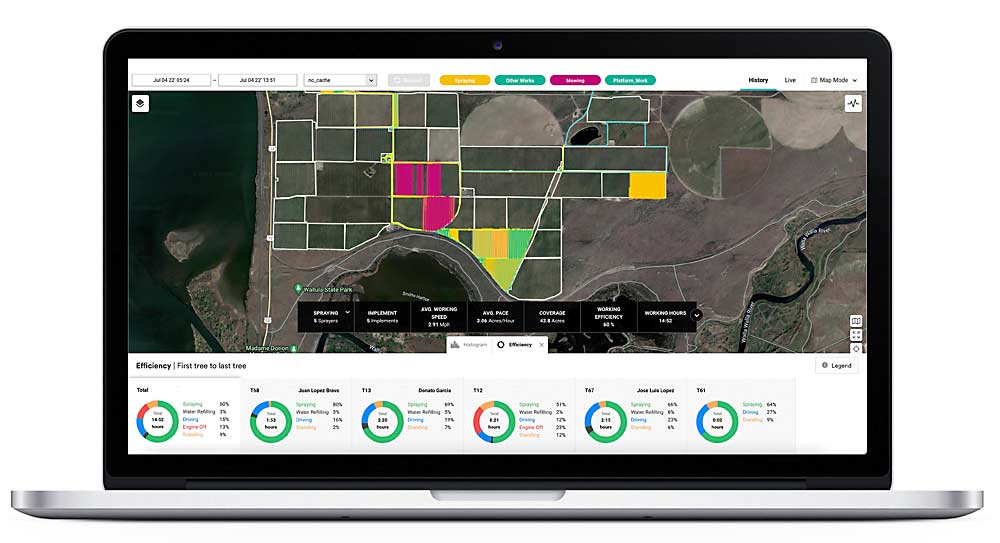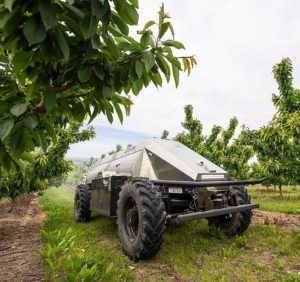
How do you know if a prescribed pesticide covered the canopy at the right rate, or if your applicator inadvertently skipped a row or spent 30 minutes idling in line to refill?
“I remember when I used to go with my father to the field to see the tire tracks in the row. Because that’s all you can see,” said Iftach Birger, chief operating officer of Fieldin, a technology company he cofounded 10 years ago in Israel to give growers insight into spray execution. Now, he’s based in the company’s California headquarters. “The challenge is between what you think happened and what really happened.”
Using sensors to track the tractor’s path and pace, as well as the sprayer’s output, empowers growers with information needed to solve problems like missed rows, poor calibration, employees in need of better training, or inefficient spray plans. New tractors come from the manufacturers with similar sensors as well, but in specialty crops, growers tend to operate a mixed fleet of equipment from different manufacturers that isn’t designed to share data, creating the opportunity for add-on sensor companies such as Fieldin and AgOtter. That data alone has significant value, but it’s also a step on the path toward automation.
“For us, it’s an investment in where the future is going,” said Doug Gibson, vice president of Mount Adams Fruit, which outfitted one ranch with Fieldin technology this year. “Right now, it allows us to make sure people are going the right speed, not skipping rows, but in the future it will allow us to manage all these things remotely. It’s laying the groundwork.”
Both Fieldin and AgOtter are clearly pursing that path, with recent partnerships with or acquisitions of companies that retrofit automation kits.
Watch your tracks
Gibson said the data helped with productivity right away by maximizing the time sprayers spend spraying, for example, not just driving.
“There’s also a big safety element to it. If there is someone spraying at night and we don’t hear from them, we know where they are,” he said.
Fieldin attaches its sensors to all of a farm’s equipment: tractors, sprayers, mowers, cultivators, ATVs and platforms. Pricing is done as a subscription, not per sensor, but also depends on the crop type. Each operator gets a key fob, so the sensors can identify the driver, but everything else is automatic. The data dashboard shows the operations of each tractor and implement.
“When you first see this data, it’s like you were blind and now it’s eye-opening,” Birger said. That visibility helps growers better understand “what is happening on the farm and be more efficient.”
As the company expands into the Pacific Northwest this year, it’s starting to connect to picking platforms. Tracking the pace of the platform’s progress and bin filling could provide both yield and harvest efficiency metrics, Birger said, adding that it’s still work in progress.
“It’s not automating the process, it’s measurement that gives us the capability to increase the efficiency,” he said. The company has seen the same thing tracking shakers in California almond groves.
But Fieldin certainly has automation in its sights. Late last year, the company acquired Midnight Robotics, which developed a lidar-based, retrofitted autonomy kit. The lidar can also be used to adjust sprayers to canopy volume, although Birger said that feature is more relevant to the large trees of California’s nut and citrus groves than Washington’s fruiting-wall apples. The company expects to trial these autonomy retrofits in the Pacific Northwest next year and make them commercially available in 2024.
“You will not replace your fleet in one day,” Birger said. “We build a dataset together with growers and, based on this dataset, we can build on autonomy.”
A case for rate control
AgOtter doesn’t just track the spray applications, it optimizes them.
“We’re bringing rate control to orchards,” said Eric Shumaker, an Oregon-based hazelnut grower and sales rep for AgOtter, the sprayer sensor technology developed by Arizona-based Insero. The flow sensors and rate-control valves adjust output as speed changes, while GPS sensors map the actual application.
The sensors and the app also make calibration a breeze, he said, instead of a hassle that managers often skip. While the tractor sits idle, a simulation mode on the app can bump up or down the “speed” and watch how the flow meters on the sprayer respond, “so you know your rate control is matching the speed,” Shumaker said.
Over the past two years, rising product prices and limited availability have driven interest from growers. “Yes, it costs $7,500 to get into the game, but it’s a quick payback” with better use of expensive products, he said. And growers use the application analytics to find all kinds of ways to be more efficient.
The company also integrates its data with Agrian and Conservis to automate spray records. And a new partnership with Blue White Robotics could eventually automate the applications themselves. (See “Ag automation headed your way.”)
“You can’t have autonomous vehicles without rate control,” Shumaker said. “We’re the ones in the background making that happen.” •
—by Kate Prengaman







Leave A Comment